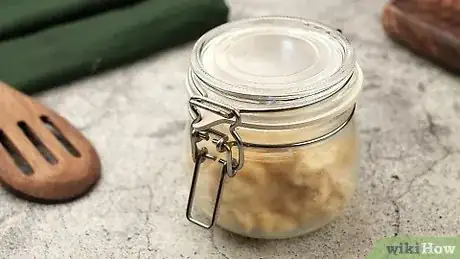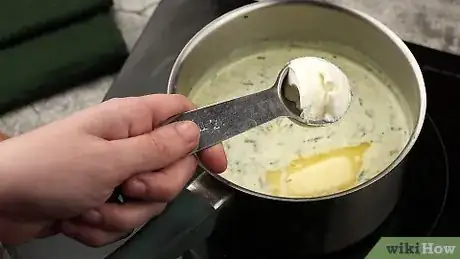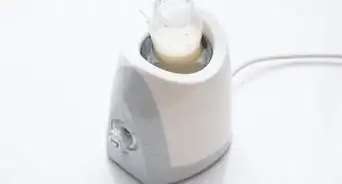This article was co-authored by wikiHow Staff. Our trained team of editors and researchers validate articles for accuracy and comprehensiveness. wikiHow's Content Management Team carefully monitors the work from our editorial staff to ensure that each article is backed by trusted research and meets our high quality standards.
There are 10 references cited in this article, which can be found at the bottom of the page.
The wikiHow Culinary Team also followed the article's instructions and verified that they work.
This article has been viewed 64,763 times.
Learn more...
One of the easiest ways to thicken milk is by boiling it on the stove. As it heats up, the liquid parts of the milk will start to evaporate. Remember to keep stirring the whole time! If you want to make condensed milk, add sugar before you heat it up. Once the milk has thickened, you can eat it on toast, cook with it, or store it for a few days in the fridge. If you want to thicken a milk-based sauce, reduce it on the stove or add thickeners like flour or cornstarch.
Ingredients
- Fresh, whole milk
- 2 cups (470 ml) of whole milk
- 2/3 cups (85 g) of white sugar
Steps
Boiling Milk to Make Khoya
-
1Get fresh, full-fat milk to make khoya. Whole milk will work much better than skim or reduced-fat. Khoya is a thickened, evaporated milk that’s common in Indian recipes. You can buy it at an Indian grocery store, but it’s much tastier to make it at home by boiling fresh, full-fat milk on the stove.[1]
- Khoya is also sometimes called mawa, so if you see mawa in a recipe, make this.
-
2Measure out milk and pour it into a heavy-bottomed saucepan. Use however much milk you’d like. It will reduce in volume by about half, so if you want to end up with 1 cup (240 ml) of khoya, start with 2 cups (470 ml) of milk.
- The saucepan can be any with a thick bottom, to keep the milk from burning. You can use cast iron, aluminum, or stainless steel.[2]
Advertisement -
3Bring the milk to a gentle boil over medium heat. Pour the whole milk into a large, heavy-bottomed saucepan and place the saucepan on the stove. Turn the heat to medium so that the milk comes to a boil.[3]
- Don’t cover the saucepan, because you want the liquid to evaporate.
-
4Simmer the milk over low heat for about 2 hours. Once the milk starts to boil, turn it down to low heat so that it is a gentle simmer. Leave it on the burner for about 2 hours. Make sure you are in the kitchen the whole time, because it’s dangerous to have a burner on without anybody there. Gradually the milk will start to darken in color until it looks like a deep yellow.[4]
- Do this while you are simultaneously cooking other things or doing other chores around the kitchen, so you don’t get bored.
-
5Stir the milk with a spatula every 3-4 minutes. You don’t have to be stirring the milk constantly the entire time it takes to evaporate, but give it a stir every 3 or 4 minutes. If you see solids sticking to the sides of the pot, scrape them off with a spatula so that they can incorporate, or scoop them out if you prefer. Either way is fine.[5]
- Use a wide spatula so that you can cover more of the pan at once.
-
6Remove the milk from the heat once it stops bubbling. This means that most of the liquid has evaporated, and the milk will be the right thickness and consistency for khoya. If you want to, you can remove extra solids with a strainer.[6]
- You can also keep the solids in if you prefer.
-
7Let the khoya cool and transfer it to an airtight container. It will take about 20-30 minutes for the khoya to completely cool. It will cool more quickly if you remove it from the still-hot pan. When it’s still hot, don’t put it on plastic, which can melt. Keep it in glass or metal. Once it is completely cool, you can put it in a plastic or glass container with a lid.[7]
- Make sure the khoya is completely cool before you put it in the refrigerator.
-
8Store khoya an airtight container in the refrigerator for 3-4 days. Make sure to label the container with the contents and the date you made it. Khoya lasts in the refrigerator for about 3-4 days before it starts to go bad, smelling strange and potentially growing mold.[8]
- When you want to use your khoya you can just take a scoop out, or use the whole thing at once.
-
9Store khoya in the freezer is you want it to last up to a month. Pour the khoya into an airtight container and label it with the date you made it. Then put it in the freezer. When you want to use it, put it in the refrigerator so that it can thaw for several hours.[9]
- Freezing khoya is a good option if you have made a batch far in advance of when you want to use it.
-
10Use khoya in sweet and savory dishes. Khoya, or mawa, is the main ingredient in many north-Indian sweets, including barfis, pedas, laddu, and kalwas. You can also use it in savory recipes, like khoya kaju curry, newabi kesar koftas or peshawari paneer.[10]
- If you’re not too familiar with Indian cooking, get an Indian cookbook or look at recipes online.
Making Condensed Milk
-
1Pour the milk and sugar into a heavy-bottomed saucepan. Measure out 2 cups (470 ml) of whole milk and 2/3 cups (85 g) of white sugar and pour them both into a small saucepan. Set the saucepan on the stove.[11]
- Using a saucepan with a heavy bottom insulates the milk and sugar a little bit from the heat, keeping them from burning.
-
2Heat the milk and sugar on low heat and stir until the sugar dissolves. Turn the burner to low heat, and stir the milk and sugar with a spatula as they heat up. Gradually the heat will dissolve the sugar crystals.[12]
- Use a wide spatula to stir so that it’s easier to get at the whole bottom of the pan.
-
3Simmer the mixture over medium low heat for 30-40 minutes. Do not stir the mixture while it’s simmering, because that can cause it to crystalize. The milk will darken in color to a deep yellow, reduce in volume, and thicken.[13]
- Skim off any foam with a spoon whenever you see it forming.
- Don’t stir sugar crystals from the rim of the pot into the milk.
-
4Remove the mixture from heat and let it cool completely. Pour it into a class jar to cool. It will cool much faster than if you let it sit in the hot saucepan. Make sure to let it cool completely before you put on a lid or put it in the fridge.[14]
- If you’re not planning on using your condensed milk immediately, then make sure you label the jar with what it is and what date you made it on.
-
5Store condensed milk in the fridge for up to 6 months. Make sure to label your jar with the date that you made it, so you’ll know when it’s still good to use for your baking. Tons of sweet dessert recipes use condensed milk, including pies, cakes, cupcakes, fudge, cheesecakes, fondue, tarts. The options are endless![15]
- You can also eat condensed milk plain on toast for a sweet snack.
Thickening Milk-Based Sauce
-
1Reduce the sauce over low heat. If your milk-based sauce isn’t as thick as you would like it to be, pour it into a pot and put the pot on the stove. Bring the sauce to a low simmer, and stir until it reaches the thickness you’d like.
- While the sauces heats up, water will evaporate out. It’s a simple way to thicken dairy sauce.
-
2Stir in a piece of cold butter. Once you’ve reduced the sauce, if it’s still not thick enough for your liking, you can stir in a piece of cold butter. The heat of the sauce will immediately make the butter melt and incorporate into the sauce.
- If you want a lower fat option, stir in a dollop of low-fat yogurt instead.[16]
-
3Stir in a dollop of cream cheese or sour cream for a tart sauce. If you’re trying to make a sweet milk-based sauce, this probably isn’t the right option for you. But if you don’t mind your sauce being on the sweet side, then a dollop of cream cheese or sour cream will do a great job thickening up your sauce.[17]
- Don’t worry if your cream cheese is quite hard. It will melt into the warm sauce.
-
4Thicken sauce with cornstarch. If you’d like, you can thicken your milk-based sauce by stirring in a slurry made from cornstarch and water. Whisk together equal parts of cold water and cornstarch. Then whisk the slurry into your sauce, adding 1 tablespoon (15 mL) at a time. Stir the sauce over medium heat for 2 minutes until the cornstarch is incorporated.[18]
- You will need about 2 tablespoons (30 mL) of cornstarch slurry for each cup of sauce.
-
5Use flour to thicken your sauce. For every 1 cup (240 mL) of sauce that you want to thicken, stir together 2 tbsp (28.3 g) of flour with .25 cups (59 mL) of water. Stir the flour into the water thoroughly to prevent lumps, and then stir it into the sauce. Cook the sauce over medium heat until it is thickened, and then heat it for one minute more to make sure the flour is cooked.[19]
Things You’ll Need
Boiling Milk to Make Khoya
- Heavy-bottomed saucepan
- Spatula
Making Condensed Milk
- Bowl
- Electric mixer
References
- ↑ https://www.vegrecipesofindia.com/khoya-mawa-recipe-homemade-khoya-mawa/
- ↑ https://www.chowhound.com/post/thick-bottomed-heavy-pot-824569?page=2
- ↑ https://www.spiceupthecurry.com/khoya-recipe-homemade-mawa/
- ↑ https://youtu.be/CGPJ1wd3ZrY?t=34
- ↑ https://www.vegrecipesofindia.com/khoya-mawa-recipe-homemade-khoya-mawa/
- ↑ https://youtu.be/CGPJ1wd3ZrY?t=43
- ↑ https://www.vegrecipesofindia.com/khoya-mawa-recipe-homemade-khoya-mawa/
- ↑ https://www.vegrecipesofindia.com/khoya-mawa-recipe-homemade-khoya-mawa/
- ↑ https://www.spiceupthecurry.com/khoya-recipe-homemade-mawa/
- ↑ https://www.tarladalal.com/recipes-using-mawa-490
- ↑ https://www.biggerbolderbaking.com/how-to-make-condensed-milk/
- ↑ https://www.biggerbolderbaking.com/how-to-make-condensed-milk/
- ↑ https://www.biggerbolderbaking.com/how-to-make-condensed-milk/
- ↑ https://www.biggerbolderbaking.com/how-to-make-condensed-milk/
- ↑ https://www.tasteofhome.com/collection/sweetened-condensed-milk-recipes-to-satisfy-your-sweet-tooth/
- ↑ https://realmealrevolution.com/real-thinking/8-ways-to-thicken-a-sauce-with-dairy/
- ↑ https://realmealrevolution.com/real-thinking/8-ways-to-thicken-a-sauce-with-dairy/
- ↑ https://www.bhg.com/recipes/how-to/cooking-basics/thickening-with-cornstarch-or-flour/
- ↑ https://www.bhg.com/recipes/how-to/cooking-basics/thickening-with-cornstarch-or-flour/































































